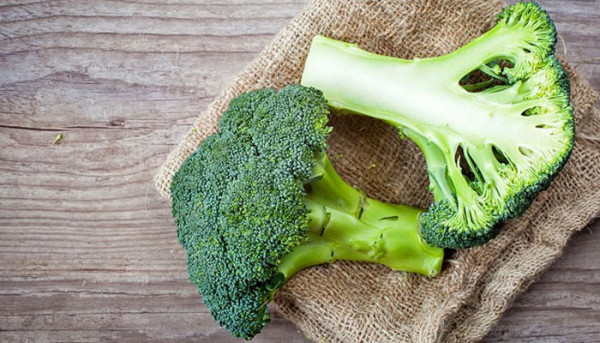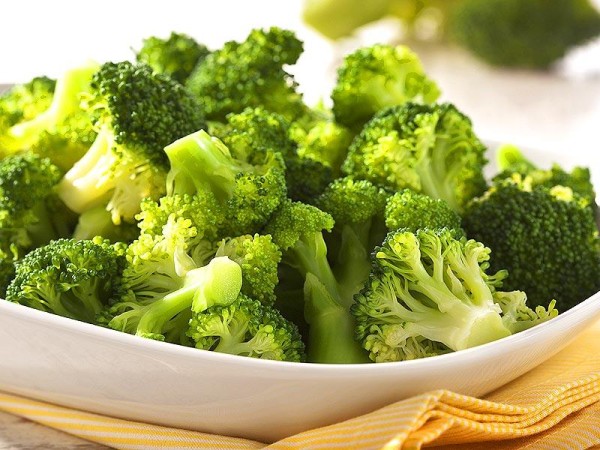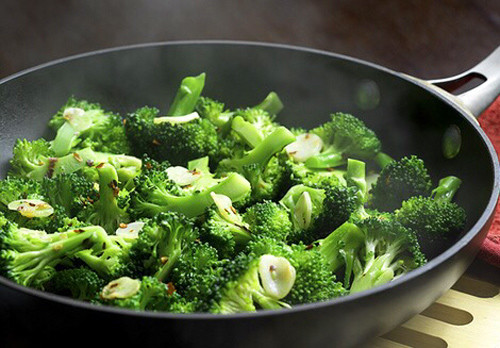The benefits and harms of broccoli
Gone are the days when everything was ordinary on the table of a Russian person - potatoes, cabbage, meat, cucumbers, tomatoes. Today we know that every vegetable has many varieties and varieties. Sweet potatoes, broccoli and Brussels sprouts, Chinese cucumbers. The topic of this article is broccoli. What is useful and what is harmful in this vegetable. And how to use it correctly.
Content
The benefits of broccoli 
It only seems at first glance that a vegetable with a not pronounced taste cannot have a rich supply of usefulness in its cells. In fact, this species is the leader in usefulness and nutritional value among cabbage varieties. And what did this first place broccoli deserve, I wonder?
What kind vitamins and micronutrients are included in broccoli:
- A - equal to carrots in content;
- C - the amount contained is superior to citrus fruits;
- E;
- group B;
- U - a vitamin that has the property of delaying the development of ulcers and erosion, is always in short supply in the body;
- cellulose;
- proteins fats carbohydrates;
- omega 3;
- potassium;
- magnesium;
- zinc;
- selenium;
- iodine;
- iron, etc.
The beneficial effects of broccoli on the human body:
- strengthening the immune system;
- health improvement the whole organism;
- cleansing Gastrointestinal tract from slags and toxins;
- fight against ulcers and erosion;
- potassium fights excess water;
- regulation of sugar levels and production of insulin;
- antioxidant property slows down cell aging;
- high calcium content (about 50 mg per 100 g of product) has a beneficial effect on teeth, bones, hair;
- rich in digestible protein than won the hearts of athletes;
- powerful natural anti-inflammatory, able to resist cancer;
- prevention of malignant tumors in the genitals and mammary glands;
- improving the work of the cardiovascular system;
- maintains the number of beneficial microorganisms in the digestive tract;
- less than 30 calories in 100 grams of product;
- level adjustment cholesterol in blood;
- the fight against excess weight, due to the high content of vitamin K, which promotes the synthesis of vitamin D;
- benefit for the organs of vision.
Damage to broccoli 
To date, scientists have not established the harm from eating this vegetable. But like any other product, there is at least one warning. Remember that everything is good in moderation. It is unlikely that your body will thank you if you switch completely to the broccoli menu. To saturate with all the necessary substances, it is suitable to eat cabbage a couple of times a week.
Also, the presence of allergic reactions is possible, with individual intolerance to the product.
Remember not to fry foods with a lot of fat. No matter how useful they are, fat will override any benefits. Any vegetable must be cooked so that all nutrients remain in it as much as possible. How to do it correctly? Let's talk a little later.
Contraindications for broccoli 
Probably the only and fairly rare cases when this cabbage can be contraindicated:
- disruption of the pancreas;
- increased acidity of the gastrointestinal tract;
- after the operating diet, where it is strictly forbidden to eat raw vegetables.
This vegetable must be eaten during pregnancy. Because it contains a lot of vitamin C, folic acid and chlorophyll. These substances are extremely important for a child at any stage of growth. And for mom, cabbage is useful because it is strong immunity has never harmed anyone yet.
How to eat broccoli 
Before revealing the secrets of its proper preparation, I would like to talk about how to buy a quality product.
Signs of a good cabbage:
- dense head of cabbage and hard stems;
- there are no yellow dots among the inflorescences, yellow is a sign of an old vegetable;
- cabbage smell, without unpleasant notes;
- inflorescences are dark green, even slightly purple;
- no spots of rot;
- the vegetable is firm, there are no signs of lethargy or staleness.
Remember to store fresh cabbage only in the cold. Having created a moist environment for the stems, put a bouquet of cabbage in water or wrap it with damp paper. If you prefer the proven method of storage - in a bag, then punch holes in it. This will provide fresh air and keep the vegetable from rotting.
By the way, if we talk about the difference between a fresh vegetable and its frozen counterparts, then the second option is preferable. Because if cabbage "travels" to the table for more than a week, then during this time on the way almost half of all its vitamins are lost. While when the product is frozen, only 10% of the nutrients are lost. Therefore, it is preferable to buy a deep-frozen product or grow cabbage yourself.
How to properly freeze cabbage in order to preserve its properties as much as possible:
- Wash the cabbage and divide into stalks.
- Put a large pot of water on the gas and bring it to a boil.
- Dip broccoli in boiling water for a couple of minutes.
- Catch it with a slotted spoon and immediately put it in a container with ice water.
- Repeat if necessary with the following portions.
- Spread the finished cabbage on a paper towel and let dry.
- Fold in bags and put in the freezer.
Please note that you should not throw away the small leaves at the bottom of the head of cabbage. Yes, they seem stupid at first glance. But in fact, it is in them that the greatest concentration of nutrients is.
It is easy to "revive" a withered vegetable - cut a little from the stalk and put the cabbage in the water.
Rating of the method of consumption depending on the usefulness:
- Raw. Without subjecting cabbage to any processing, you can get all its benefits in its pure form.
- Steam cooking. This cooking method is able to preserve the maximum amount of nutrients compared to other types of heat treatment.
- Extinguishing is also a rather gentle method.
- Baking in the oven. Recommended under a cheese cap.
- Boiling in water.
- Frying in oil negates the benefits of any product.
We bring to your attention the best video recipes with cabbage


